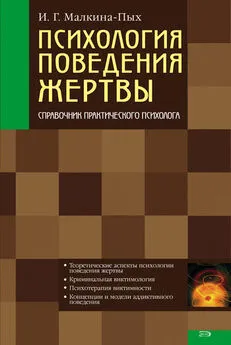Ирина Малкина-Пых - Психология поведения жертвы
- Название:Психология поведения жертвы
- Автор:
- Жанр:
- Издательство:неизвестно
- Год:неизвестен
- ISBN:нет данных
- Рейтинг:
- Избранное:Добавить в избранное
-
Отзывы:
-
Ваша оценка:
Ирина Малкина-Пых - Психология поведения жертвы краткое содержание
В справочнике рассмотрены предмет, история и перспективы виктимологии, проанализированы соотношения понятий типов жертв и видов виктимности, а также существующие виды и формы насилия. Особое внимание уделено анализу психологических теорий, которые с различных позиций объясняют формирование повышенной виктимности личности, или «феномена жертвы».
В книге также рассматриваются различные ситуации, попадая в которые человек становится жертвой, а именно криминальные преступления и захват заложников; такие специфические виды насилия, как насилие над детьми, семейное насилие, сексуальное насилие (изнасилование), школьное насилие и моббинг (насилие на рабочем месте). Рассмотрена виктимология аддиктивного (зависимого) поведения. Описаны как подходы к индивидуальному консультированию в каждом из указанных случаев, так и групповые формы работы в виде тренингов.
Данный справочник представляет собой удобный источник, к которому смогут обратиться практики, исследователи и студенты, для того, чтобы получить всеобъемлющую информацию по техникам и инструментам коррекционной работы как с потенциальными, так и реализованными жертвами различных экстремальных ситуаций.
Психология поведения жертвы - читать онлайн бесплатно полную версию (весь текст целиком)
Интервал:
Закладка:
Neal A. National trauma and collective memory. Major events in the American century. New York, 1998.
Neill J.R. Addiction phenomenon // South. Med.J., 1991. V. 84(8), P. 1003–1006.
Notman M.T., Nadelson C.C. The rape victim: Psychodynamic considerations // Am. J. Psychiatry. 1976. V. 133. P. 408–413.
Ochberg F.M., Willis D.J. (Eds.) Psychotherapy with victims // Psychotherapy (special issue). 1991. V. 28(1).
Ogata S.N., Silk K.R., Goodrich S. et al . Childhood sexual and physical abuse in adult patients with borderline personality disorder // American Journal of Psychiatry. 1990. V. 147. P. 1008–1013.
Olson P.A. The terrorist and the terrorized: Some Psychoanalytic considerations // The Journal of Psychohistory. 1988. V. 76(1). P. 53–54.
Olweus D. Low School Achievement and Aggressive Behaviour in Adolescent Boys // Magnusson D., AllenV. (Eds.) . Human Development. An interactional Perspective. New York: Academic Press, 1983.
O’Reilly M. Internet addiction, a new disorder enters the medical lexicon // CMA Journal. 1996. V. 154(12). P. 1882–1883.
Orzack M. H. Internet Addiction Treatment. Electronic message posted to Research Discussion List, 1996.
Palmer St., McMahon G. (eds). Handbook of counselling. London: Routledge, 1997.
Pence E. et al. Education groups for men who batter. The Duluth Model. New York: Springer, 1993.
Pendleton L., Moll S.H., Tisdale M.J., Marler, M.R. The 4,5,6 configuration on the MMPI in bulimics VS, controls // J. Chin. Psychol. 1990. V. 46(6). P. 811–816.
Petzold E., Reindell A. Klinische Psychosomatik. Quelle amp; Meyer, Heidelberg (UTB 991), 1980.
Pitman R.K. Post-traumatic Stress Disorder, Conditioning, and Network Theory // Psychiatric Annals. 1988. V 18.
Potera C. Trapped in the web // Psychology Today, 1998. V. 31(2), P. 66–69.
Praterelli M.E., Browne B.L., Johnson K. Internet addiction, a factor analytic approach // Behavior research methods. 1999. V. 31. P. 305–314.
Probst M. Body experience in eating disorder patients. Kortenberg: University Center Sint Jozef, 1997.
Prultt J.A., Kappius R.E., Gorman P.W. Bulimia and fear of intimacy // J. Clin. Psychol. 1992. V. 48(4). P. 472–476.
Rado S. Narcotic bondage: a general theory of the dependence on narcotic drugs // American Journal of Psychiatry. 1957. V. 114. P. 165–170.
Rado S . The psychic effects of intoxicants: an attempt to evolve a psychoanalytical theory of morbid cravings // International Journal of Psychoanalysis. 1926. V. 7. P. 396–413.
Renner K. E., Wackett C., Ganderton S. The social nature of sexual assault // Canadian Psychology. 1988. V. 29(3). P. 163–354.
Resick P.A., Jordan G.C., Girelli S.A., Hutter G.K. A comparative outcome study of behavioral group therapy for sexual assault victims // Behavior Therapy. 1988. V. 19. P. 385–401.
Ricca V., Mannucci E., Zucchi T., Rotella C.M., Faravelli C . Cognitive-behavioral therapy for bulimia nervosa and binge-eating disorders // Psychother. Psychosom. 2000. V. 69. P. 287–295.
Ritchi J. The Secret World of Cults. An Angus amp; Robertson Book, 1991.
Roger D., Jarvis G., Najarian B. Detachment and Coping // Personality and Individual Difierences. 1993. V. 15(6). P. 619–626.
Rosenhan D.L., Seligman M.E.P. Abnormal Psychology. New York: W. W. Norton and Company, 1989.
Rotter J.B. Generalized expectancies for internal versus external control of reinforcement // Psychological Monograpghs. 1966. V. 80(609).
Rotter J.В., Chance J.E., Phares E.J. Applications of a Social Learning Theory of Personality. New York, 1972.
Rowan A.B., Foy D.W. Post-Traumatic Stress Disorder in Child Sexual Abuse Survivors, A Literature Review // Journal of Traumatic Stress. 1993. V. 6. P. 3 – 20.
Salzman J.P. Etiology of borderline personality disorder // American Journal of Psychiatry. 1988. V. 155(11). P. 16–26.
Sanderman R. Life events, mediating variables and psychological distress: A Longitudinal study. Groningen: Universiteitdrukkerij RUG, 1988.
Saunders B.E., Villeponteaux L.A., Lipovsky J.A. et al. Child sexual assault as a risk factor for mental disorders among women: A community survey // Journal of Interpersonal Violence. 1992. V. 7. P. 189–204.
Saunders D.G . Cognitive and behavioral interventions with men who batter: Application and outcomes // Caesar P. L., amp; Hamberger L. K. (Ed.) . Treating men who batter: Theory, practice, and programs New York: Plenum, 1989. (P. 77 – 100).
Savitt R.A. Clinical communications: Extramural psychoanalytic treatment of a case of narcotic addiction // Journal of the American Psychoanalytic Association. 1954. V. 2. P. 494–502.
Schaefer K., Schwarz D. Verhaltenstherapeutische Ansatze fьr Anorexia nervosa // Z. Psychol. Psychother. 1974. V. 22. P. 267–284.
Schiff A., Schiff J.L. Passivity // Transactional Analysis Journal. 1971. V. 1. P. 71–75.
Schwitzgebel R.L., Schwitzgebel R.K. (Eds.) Sychotechnology, Electronic cоntrol of mind and behavior. New York: Holt, 1973.
Scott M. A cognitive-behavioral approach to clients’ problems. New York: Routledge, 1989.
Selvini-Palazzoli M. Die Familie des Anorektikers und die Familie des Schizophrenen. Eine transaktionelle Untersuchung. Ehe. 1975. P. 107–116.
Selvini-Palazzoli M., Boscolo L., Cecchin G., Prata G . Paradoxon und Gegenparadoxon. Klett-Cota. Stuttgart, 1977.
Shaffer H.J., Hall M.N., Van der Bilt J. Computer addiction, a critical consideration // American J. of orthopsychiatry. 2000. V. 70(2). P. 162–168.
Sheldon K.M., King L. Why positive psychology is necessary? // American psychologist. 2001. V. 54. P. 35–47.
Shepherd M.F., Pence E.L. Coordinating community responses to domestic violence: Lessons from the Duluth model. Thousand Oaks, CA: Corwin Press, 1999.
Singer M. T. Coming out of the cults // Psychology Today. 1979. V. 12. P. 72–82.
Singer M. T. Group psychodynamics // Berkow R. (Ed.) . The Merck manual of diagnosis and therapy (15th ed.). Rahway, NY: Merck, 1987. P. 1467–1471.
Singer M. T., Temerlin M., Langone M.D. Psychotherapy cults // Cultic Studies Journal. 1990. V. 7(2). P. 101–125.
Singer M.T. Coming out of the cults // Psychology Today. 1979. V. 2. P. 72–82.
Singer M.T., Temerlin M.K., Langone M.D. Psychotherapy cults // Cultic Studies Journal. 1990. V. 7. P. 101–125.
Sirkin M., Grellong B.A. Cult vs. non-cult Jewish families; Factors influencing conversion // Cultic Studies Journal. 1988. V. 5. P. 2 – 23.
Solomon L., Kriegman D. Psychotherapy and the «New Religions»: Are They the Same? // Cultic Studies Journal. 1984. V. 1(2).
Spangler D.L. Cognitive-behavioral therapy for bulimia nervosa: An illustration // J. Clin. Psychol. 1999. V. 55. P. 699–713.
Stein D.J. Internet addiction, internet psychotherapy // American J. of Psychiatry. 1996. V. 153(7). P. 861–869.
Steiner C. Emotional literacy training, the application of transactional analysis to the study of emotions // Transactional Analysis Journal. 1996. V. 26. P. 31–39.
Steiner C . Script and Counter-script // Transactional Analysis Bull. 1966. V. 5. P. 133–135.
Steiner C. Scripts people live. New York: Grove Press, 1974.
Steiner C., Steiner V. Permission Classes // Transactional Analysis Bull. 1968. V. 7. P. 45–52.
Stone M.H. Essential papers on borderline disorder. New York: Penguin, 1986.
Strober M. Disorders of the self in anorexia nervosa: An organismic-developmental paradigm. // Johnson C.L. (Ed.) , Psychodynamic Treatment of Anorexia nervosa and Bulimia. New York: Guilford, 1991. P. 354–373.
Suler J. (1996, May). Internet addiction support group. Available, http//www.rider.edu/ users/suler/psycyber/ supportgp.html
Sullivan S. Do You Want to Reduce Your Gambling? A Self-help Manual. Auckland: The Tindall Foundation, 1998.
Sutherland S., Scherl D. Patterns of response among victims of rape // Am. J. Orthopsychiatry. 1970. V. 109. P. 503–511.
Sykes C.J. A nation of victims. The decay of the American character. New York: St. Martin’s press, 1992.
Taibi K., Hedges C. The Miniscript // Transactional Analysis Journal. 1974. V. 4. P. 67–82.
Thomas K.W. Toward Multidimensional Values in Teaching. The Example of Conflict Behaviors // Academy of Managment Review. 1977.
Torem M.S. Medications in the treatment of dissociative identity disorder. Spira J.L. (ed) // Treating Dissociative Identity Disorder. San Francisco: CA, Jossey – Bass, 1996. P. 99 – 132.
Trumble J.G. Rescurse in addiction psychiatry // Med. 1996. V. 99. P. 71–74.
Uexkull Th. von. Psychosomatische Medizin, 4. Aufl. Urban amp; Schwarzenberg. Munchen. 1990.
van der Kolk B. A., Fisler R. Dissociation and the fragmentary nature of traumatic memories: Overview and exploratory study // Journal of Traumatic Stress. 1995. V. 8 (4). P. 505–527.
van der Kolk B.A., McFarlane A. C., Weisaeth L. Traumatic stress, the effects of overwhelming experience on mind, body, and society. New York: Guilford Press, 1996.
van der Kolk B.A., Ducey C.P. The psychological processing of traumatic experience. Rorschach patterns in PTSD // J. of Traumatic Stress. 1989. V. 2. P. 259–274.
van der Veer G. Psychotherapy with Refugees. Amsterdam, SCS, 1993.
Vandereycken W., Depreitere L., Probst M. Body-Orientated Therapy for Anorexia Nervosa Patients // American Journal of Psychotherapy. 1987. April. P. 252–259.
Varela J. Psychological solutions to social problems: An introduction to social technology. New York: Academic Press, 1971.
Viano E. (Ed.). The victimology handbook. New York: Garland Pub. Inc., 1990.
Walker L . Psychology and Domestic Violence Around the World // American Psychologist. 1999. V. 54. P. 21–29.
Walker L. The Battered Woman Syndrome. 2nd ed. New York: Springer, 2000.
Walker M. The Psychology of Gambling. London: Butterwork – Heinemann? 1995.
Wallace H. Victimology, legal, psychological, and social perspectives. Boston, Mass., U.S.A.: Allyn and Bacon, 1998.
Wallston K.A., Wallston B.S., DeVellis R.F. Development of the Multidimensional Health Locus of Control (MHLC) scales // Health Education Monographs. 1978. V. 6. P. 160–170.
Weber G., Stierlin H. In Liebe entzweit. Rowohit, Rembek, 1989.
Weinhold B. Playing Grown-Up Is Serious Business, Breaking Free of Addictive Family Patterns. Walpole, NH: Stillpoint International, 1988.
Weinstein H . Psychiatry and the CIA. Victims of mind control. Washington, DC: American Psychiatric Press, 1990.
West I.J. Dissociative reactions // Comprehensive textbook of Psychiatry / Ed. by A. M. Freeman amp; H. I. Kaplan. Baltimore: Williams amp; Wilkin, 1967.
West L. J. Persuasive techniques in contemporary cults: A public health approach // Cultic Studies Journal. 1990. V. 7. P. 126–149. (Reprinted from Galanter, M., Ed., Cults and new religious movements. Washington, DC: American Psychiatric Association. P. 165–192).
Читать дальшеИнтервал:
Закладка:










